[Here’s a link to other forays around my map.]
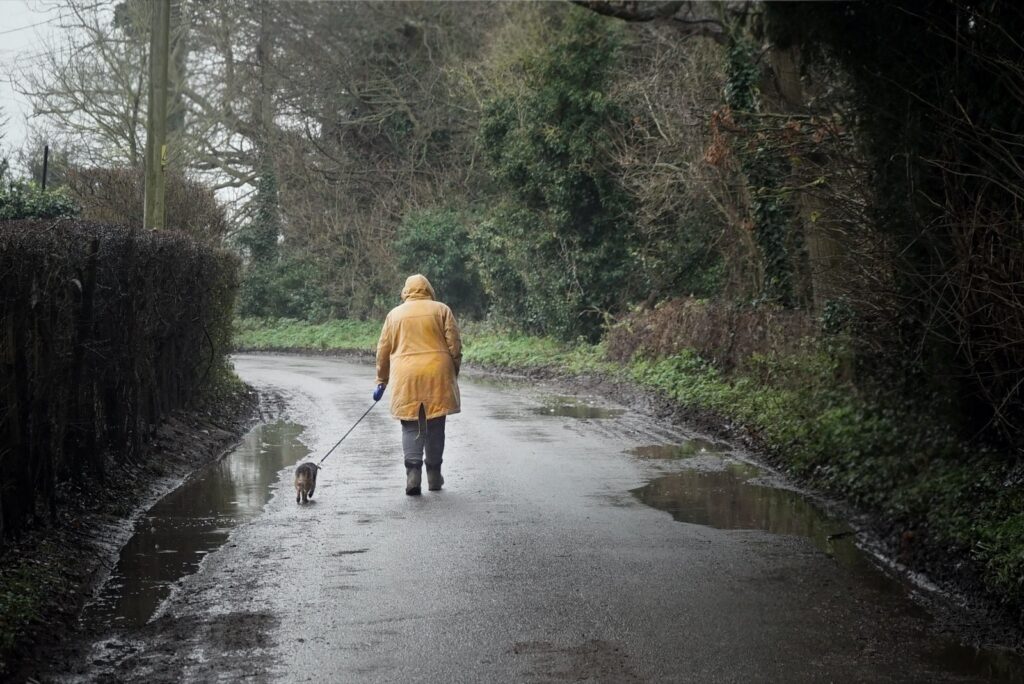

Nowhere to go. Locked down and the horizons closing in. Nothing to do. Weeks drag, and yet –simultaneously– I have little time to myself amidst the Sisyphean days of homeschooling, chores, and routine. And so when I do get the opportunity to escape I bolt for the woods. I bustle around grabbing camera, rain gear, thermos flask. At the same time I slosh a can of tomato soup into a pan, add a can of chickpeas, a handful of frozen peas and sweetcorn, and a glug of chilli sauce. By the time I’m dressed the soup is hot and I’m out the door, onto my bike, and riding.
It’s a melancholy, moody, misty morning (alas a Wednesday not an alliterative Monday) and I duck out of the rain into a shiny wet beech wood. The tree trunks are slick and almost black. The branches overhead are a dark mesh silhouetted against the white sky. The ground is brown with leaves around the old stone marking the parish boundary. But for the first time this year there are also the first signs of rebirth; the first green primrose shoots are now peeking out of the ground. The name derives from the Latin prima rosa meaning ‘first rose’ of the year, despite not being a member of the rose family. In different counties of England it is also referred to as butter rose, early rose, Easter rose, golden rose and lent rose.

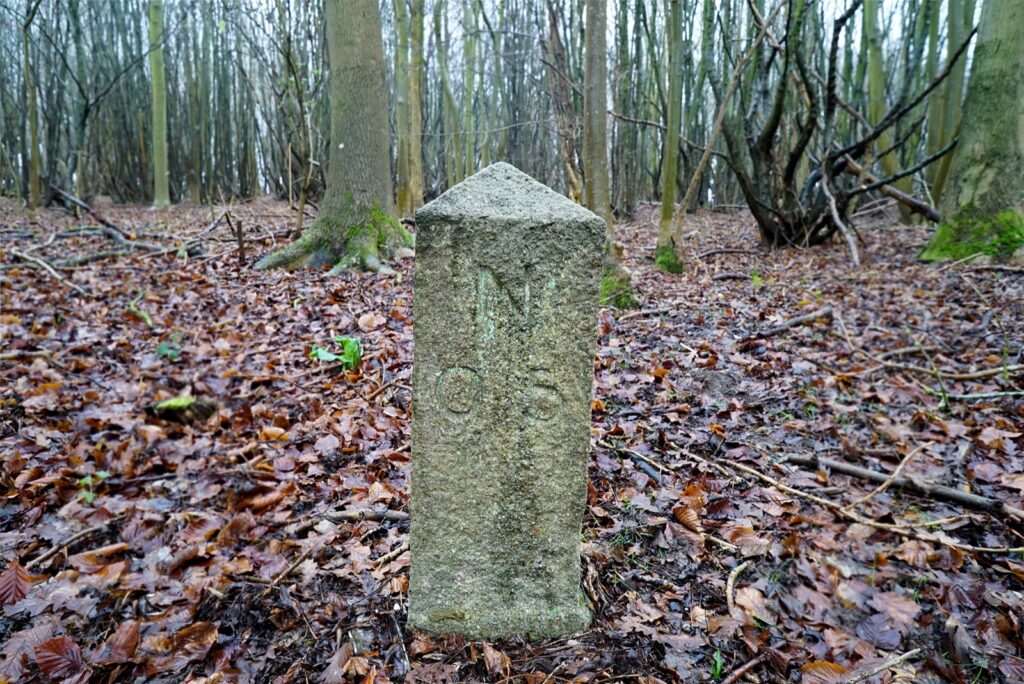
I’m ten weeks into exploring my map, ten grid squares covered out of the 400 on my map! That’s only 2.5%, and the vastness of a single map is becoming apparent! The constant surprise I feel every week is how many new places I am discovering in such a familiar landscape. Such as this small segment of path crossing a sliver of woodland, squeezed between a main road and fenced-off fields full of horses. This project is making me so appreciative of England’s network of footpaths. Getting many different views of familiar places is helping to build my affection for the area where I live.
Going for an unremarkable walk in the English countryside—damp hedges, a church, the smell of wood smoke—has a lot in common with other old British freedoms. Everyone swears by it, though no one knows quite how it works. (Nearly all land in the U.K. is privately owned, but public paths cut across it.) The practice is fiercely held but lightly talked about. Nobody “hikes.” The Ramblers date their history to 1931, the year before five hundred people defied the law to walk on Kinder Scout, a moorland plateau in the Peak District, which had been reserved for grouse shooting. The Kinder Scout protest led to the creation of Britain’s national parks. The law that established the first parks, in 1949, also called for the drawing up of so-called definitive maps, on which every parish in England and Wales was asked to record all the footpaths, bridleways (wide enough for a horse), and “roads used as a path” (cart tracks, more or less) within its borders.

It’s a pretty good bet that any public footpath you walk along has been used for hundreds, if not thousands, of years. In the centuries when travel by foot was the only means of transport for the masses, getting to the nearest market meant walking between villages. Footpaths in England generally originate from one of three sources.
Some were established as early as 5,000 BC, linking Neolithic, Bronze or Iron Age encampments. They were used by traders moving from tribe to tribe, or travellers to visit places of worship. Sometimes called green ways, they generally follow the natural contours of the landscape.
The second source are Roman roads and tracks. Built during the Roman occupation of Britain from 43 AD to 410 AD, these routes were used to move men and supplies quickly around the country.
The third are Anglo-Saxon footpaths. Although some Anglo-Saxons came to Britain to fight, many family groups settled peacefully to farm the land. They tended to ignore abandoned Roman buildings and establish their own villages, sometimes consisting of just two or three families. Over the period 400 AD to 800 AD many of today’s villages and towns were established in this way, with footpaths leading from one settlement to another.

Whilst it is difficult to date a footpath with any accuracy, it is at least possible to judge if hundreds of years old from a few simple clues.
The easiest way to date a footpath is to date the villages it travels between. Most footpaths taking you from one village to another are probably of Anglo-Saxon origin. If the villages you’re travelling between are in the Domesday Book you can reasonably be certain the path will be over 1,000 years old.
Another clue may be if the track is a hollow way, one of the most easily recognised types of ancient tracks.
The vegetation and hedging along the track may indicate its age. A rule of thumb to date a hedgerow is that of Hooper’s rule, which states the age of a hedge is equal to the number of woody species in a thirty yard stretch of hedge, times 110, plus 30 years. So a hedge with two woody species in it would be aged as 250 years. However, the hypothesis comes with a health warning that it may be out by as much as 200 years either way.
The path may be Iron Age, or even older, if it appears to almost obsessively follow the lie of the land, particularly if it leads to a prehistoric site such as a barrow. The surface may give an indication of its age, for example Roman roads may be paved or metalled.
Footpath rights are rooted in English Common Law. Today, anyone has a legally protected right to walk on public rights of way such as public footpaths. Yet, unless action is taken, 49,000 miles of footpaths in England and Wales will disappear for ever. (Find out how you can help, here.)
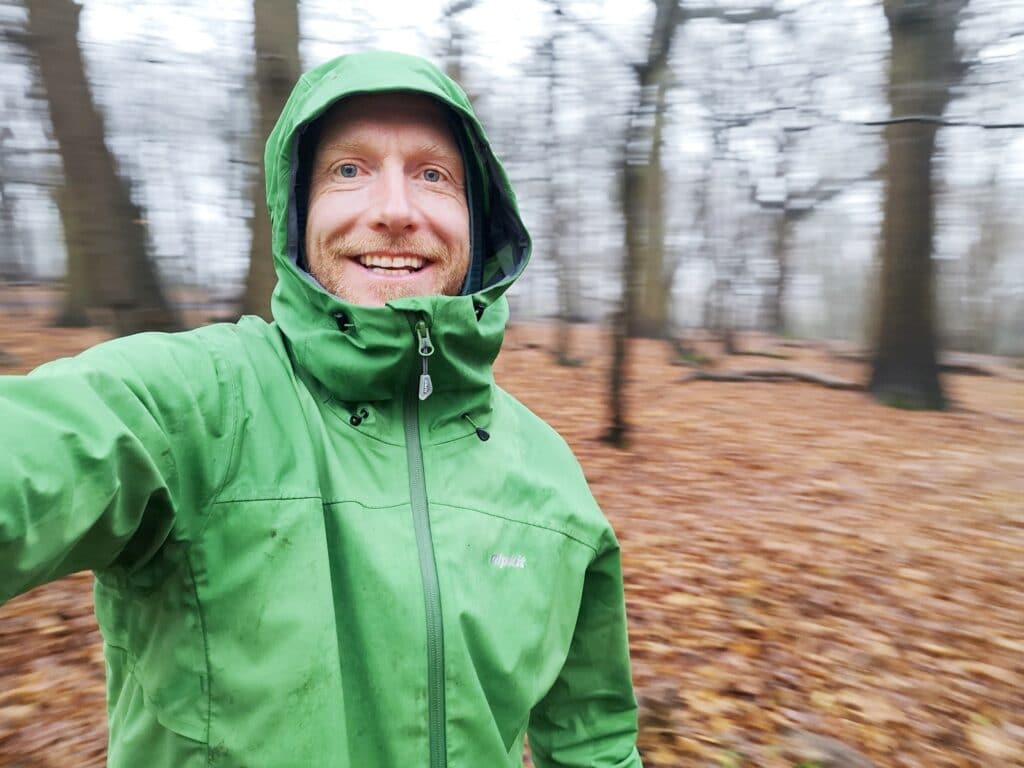
I came across the framework for a fine looking treehouse, the ground beneath it strewn with Strongbow Dark Fruit cider cans. I’m learning, across my map, that this is the default drink of local litterers. (There were also a couple of Corona beer bottles. Corona lager was one of the fast-growing grocery products in the UK this year, despite the negative associations of its name. Britons piled an additional £2.1bn worth of lager, wine and spirits into their supermarket trolleys during 2020. Supermarket sales of the Mexican beer rose 40 per cent, making it the tenth fastest-growing grocery product.)

There have been four distinctly fashionable periods for building treehouses: the Roman era, the Renaissance period, the late eighteenth century Romantic period, and the early 21st century.
The first recorded evidence of treehouses used for recreation dates from the first century AD. During the Roman era Pliny the Elder described one made for Caligula in a Plane tree at Velitrae.
Renaissance Italy saw a resurgence of their popularity and the powerful Medici family incorporated them into their gardens near Fiesole and Pratolino, thus setting a new trend. In England, treehouses became popular additions to the formal gardens of the seventeenth century. And both myself and whoever is working on this treehouse will attest that treehouses are still a lot of fun to build and to relax in here in the 21st Century. Lockdown, surely, is a time to build a treehouse if you have the opportunity!


I exited the wood, pedalled past a pair of pale blue shepherds’ huts, and made my way to a little 14th Century church. I can never resist nosing around a graveyard. I love the stories told, those left to the imagination, and the important dose of memento mori. Danny Miller “enriched our lives with his courage, humour, goodness and love. A real nice guy.” A shame then that he died at the age of just 31. Another epitaph read “He that wins knows no quitting”.
Lying on wet leaves alongside one grave was a rain-soaked envelope addressed, “To My Darling Neil”. Imagining the contents of the letter, the things left unsaid too long, perhaps, just about broke my heart. A broken heart, regrets, apologies, making peace, or consoling memories: so many stories live on in every graveyard.
Yet even here the stories do not live for ever. Older tombstones around the church were being ensnared by green fingers of ivy that climb and entwine as the wonderful wild world of nature marches remorselessly over mankind’s fleeting presence.


Clingy, luscious, misunderstood. Ivy has long been accused of strangling trees, but it doesn’t harm the tree at all. Ivy supports at least 50 species of wildlife. Ivy is an evergreen, woody climber which can grow to a height of 30m. It has climbing stems with specialised hairs which help it stick to surfaces as it climbs.
Ivy uses trees and walls for support, allowing it to reach upwards to better levels of sunlight. It is not a parasitic plant and has a separate root system in the soil and so absorbs its own nutrients and water as needed. Ivy’s presence doesn’t indicate that a tree is unhealthy, and it doesn’t create a tree-safety issue.
Wearing a wreath of ivy leaves around the head was once said to prevent one from getting drunk. The Roman god Bacchus, the god of intoxication, was often depicted wearing a wreath of ivy and grapevines. Ivy was also a symbol of intellectual achievement in ancient Rome and wreaths were used to crown winners of poetry contests. Wreaths were also given to winning athletes in ancient Greece. Research by English Heritage has shown that in some cases, ivy can help preserve stonework on old buildings, despite the common assumption that it damages buildings.

There are two apps that I’ve used on every one of my map meanderings so far. Seek is teaching me so much, and also reminding me to travel slowly, pay attention, and be curious. Today I learned about Stinking Iris, the only Iris with bright orange fruits contained within pods. The plant is variously said to smell of roast beef, foetid, or of sweetly acrid meat which is a bit ‘high’. A burst of yellow fungus caught my eye in a dark, rainy wood. Learning that it was called Hairy Curtain Crust (above) delighted me.
The second app I’ll recommend is BirdNET, the easiest way to identify birds by sound. This time of year can be almost silent, so any bird calls are a welcome interruption. They are also easier to single out compared to noisier times of the year. All I had really noticed today were the usual robins boisterously defending their patch, blackbirds’ indignant flurries at being disturbed by me, and a lone crow cawing above a soggy ploughed field.
Then a sudden raucous flurry of bird calls in a thick hedgerow, a loud outburst of what sounded like disagreement from half a dozen unhappy neighbours. The mistle thrush is a pale, black-spotted thrush – large, aggressive and powerful. It stands boldly upright and bounds across the ground. In flight, it has long wings and its tail has whitish edges. It is most likely to be noticed perched high at the top of a tree, singing its fluty song or giving its rattling call in flight.
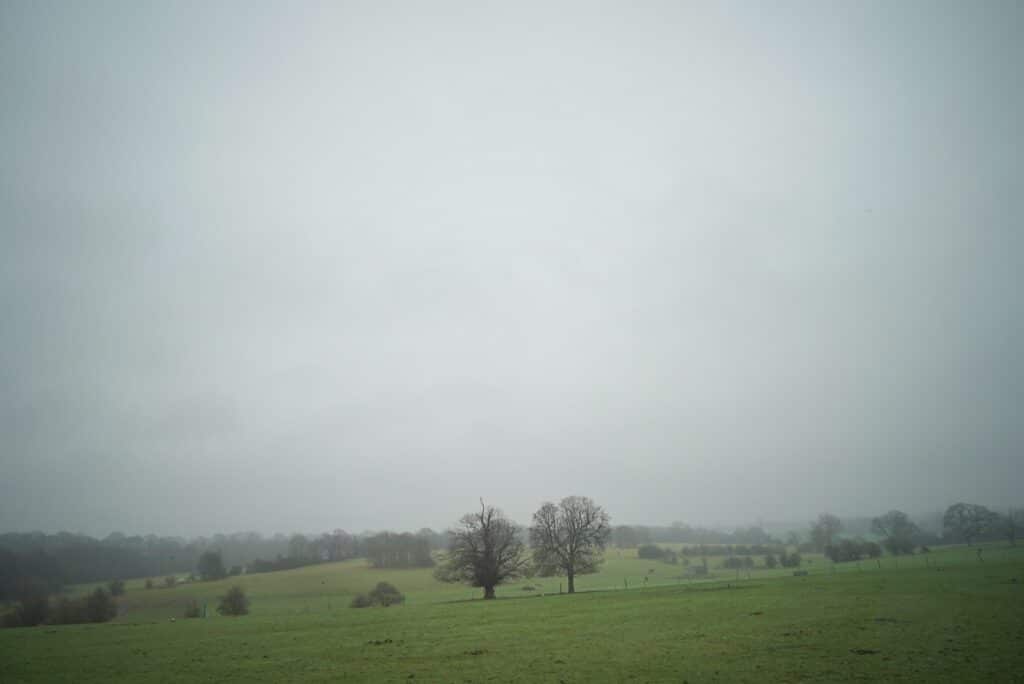
From looking at my map beforehand, I’d anticipated that today’s exploration would be a free roam across empty land. But most of the square turned out to belong to an old country house and was fenced off for horse livery and cross country eventing. Footpaths feel a let-down when they are tightly fenced on both sides. Rather than helping me enjoy the countryside, I get the impression that they are just funnelling me to go somewhere, anywhere, but not here. That seems to be missing some of the point.
Searching for open space and the freedom to meander, I pushed through a field of tall, scrubby thistles and turned into a small wood. The rain felt much lighter beneath the trees. I wasn’t the first person here. Three beehives were tucked carefully out of sight amongst head high teasels, quiet and hibernating until spring. Dirt bikes had carved what looked like a hell of a fun racing course in and around tall stands of mighty oak trees. Stands of white birch trees wore bright circles of green moss around their bases. The root systems of big old beech trees tangled amongst each other like capillaries or crochet. I liked this wood a lot.

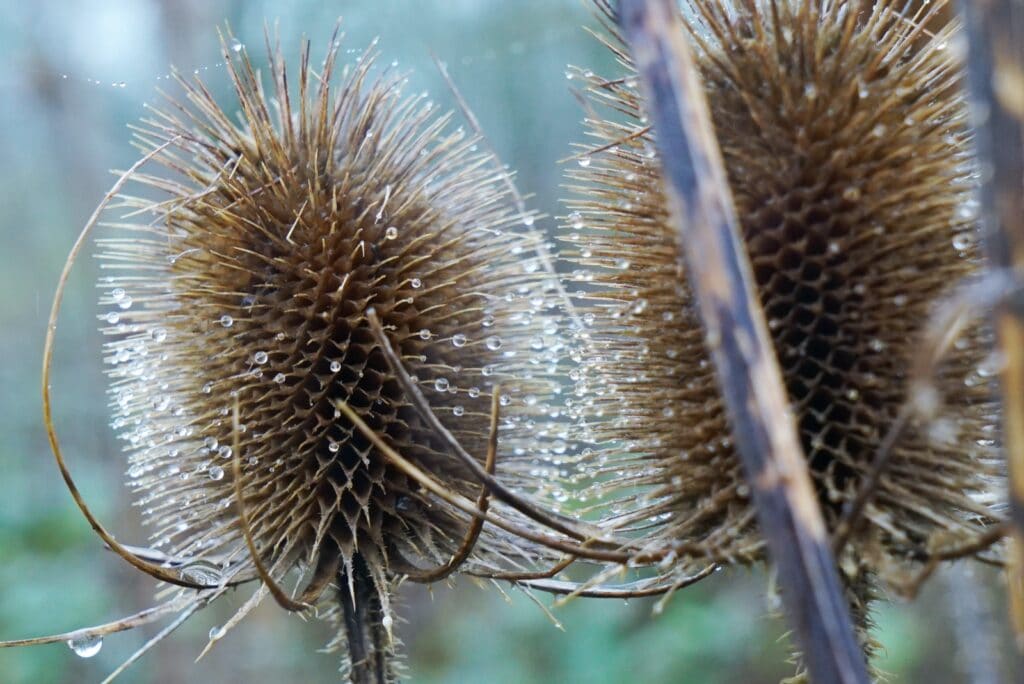

I smelled weed and spotted a pair of lurcher dogs running through the trees. Seconds after appeared a man, smoking, in a flat cap and his teenage son who had gone heavy on the Lynx deodorant. They were both carrying air rifles and scanning the tree canopy. I like how I notice my sense of smell far more in the outdoors than I do when cocooned in buildings. We chatted for a minute about the rain (as Brits do), and I asked what they were hoping to shoot.
“Squirrels, wood pigeons, anything really. But it’s raining, innit, so they’re all like ‘f*** you‘ and hiding, know what I mean? What about you?”
I answered, “a bit like you guys, really: just looking for anything interesting. I shoot with my camera though.”
I brandished my camera and they laughed and wished me luck.
A few minutes later I heard the Pop Pop Pop of pellets, the yapping excitement of the dogs, and I guessed that some squirrel or pigeon had just run out of luck.
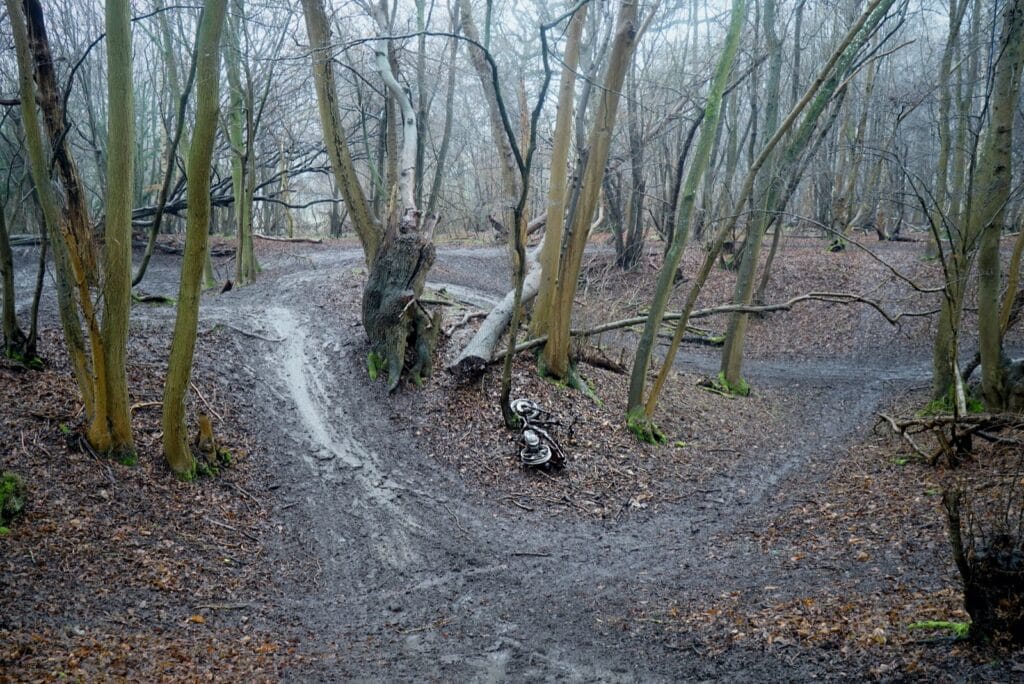
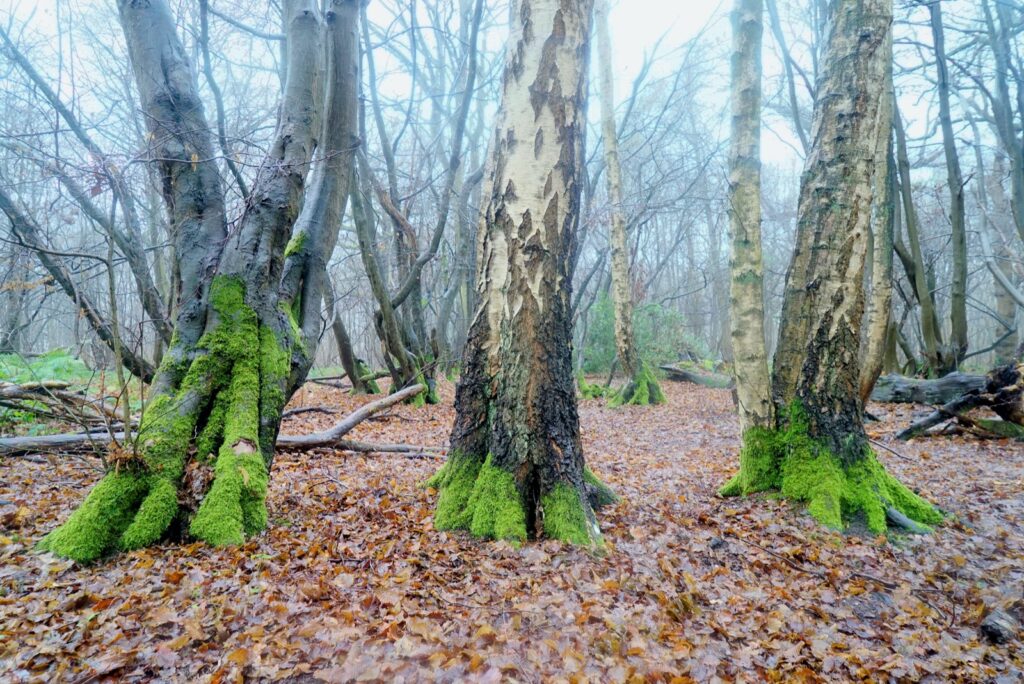
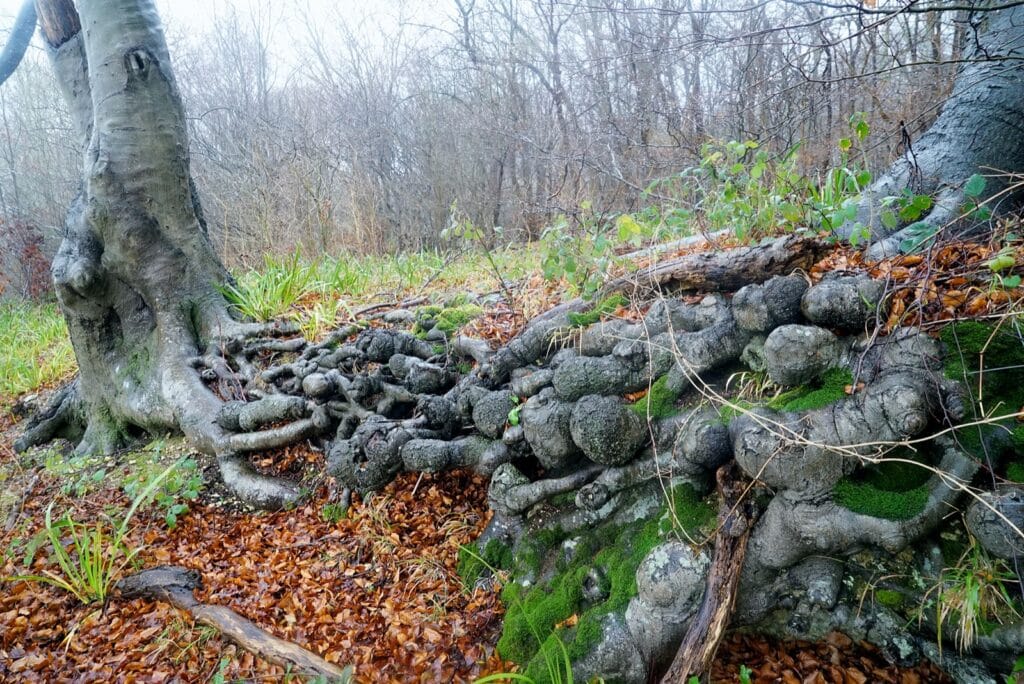
I sat on a log to drink my soup. I thought of how much I had rushed to get out today. How dissonant it was to be hurrying and clamouring to get into the stillness and calm of nature. In The Runner, Markus Torgeby writes, “I must do something about my restlessness. One day I put on several layers of clothes, sit down on a tree stump and do nothing. I must get over this hurdle, I must learn how to do nothing.” That time, he concluded, “was a good investment. Life became greater after that. Food tasted better and the song of the birds in the woods was even lovelier.”
Before Coronavirus began, about a million years ago, I was getting round to the idea of sitting still in the woods for 24 hours or more. It is a staple part of the Outward Bound training for youths in the United States.
The ‘wilderness solo’ experience derives its roots from ancient traditions in which people sought healing, rejuvenation, self-knowledge, and spiritual insight, gained through journeys and retreats into the wilderness, often alone. Moses, Jesus, Buddha, and Gandhi are examples of great leaders who regularly spent time alone in the wilderness that was associated with their personal transformation and enlightenment. (Think also of John Muir and Thoreau.)
Throughout history and across cultures, removing oneself from the demands of daily life in order to contemplate life in the silence and solitude of the wilderness has been practiced in various forms. The ‘vision quest’ is a common form of this practice, a ceremonial initiation practiced among ancient traditions, by which the individual journeyed into the wilderness for an unlimited time alone to find their individual strengths, calling, vision, and purpose in life.
This tradition of retreat into the wilderness to gain insight, guidance, and inspiration has led to the development of the modern-day, facilitated wilderness solo experience as a common intervention in the field of wilderness therapy and outdoor education.
Silence is now acknowledged by science as a significant construct of healthy human development and well-being, linked to humans’ neurobiology, psychology, physiology, and spirituality. Numerous studies and personal accounts in the field underscore the solo experience as one of the most significant nature based interventions linked to various beneficial outcomes. Although new to modern culture, solitude in nature is an ancient form of initiation used ceremonially by indigenous cultures worldwide. These practices challenge the individual who alone in the wilderness battles fear and loneliness only to discover inner strengths and true identity. The solo experience, viewed as enacting these ancient rituals in modern form may serve as an antidote to the loneliness, stress, and depression on the rise in the current era, which have been linked to our overly stimulated urban environments and lifestyles.

In our weird lockdown world I thought I had better limit myself to sitting still for an hour. We’re not allowed out overnight at the moment. If I’m honest, attempting even one hour felt somewhat daunting to me as I switched my phone to Airplane mode and set an alarm to rescue me in an hour (if I stuck it out that long).
The short version of this story is that nothing happened in that time: that I did nothing and witnessed nothing, experienced only the passage of the minutes, and the languid dynamics of my own boredom. The long version isn’t exactly The Iliad, either, but in that version something could be said to have happened. Because by the time I walked out of that circle, I’d had an entirely unexpected and intensely cathartic encounter with the passage of time, and with my own mortality.
I was bored. I fidgeted. I thought about everything and nothing at all. My emotions zipped through lethargy, delight, anger, and curiosity. As Brian Doyle wrote, “Is it hard to be silent? I ask. In the beginning it is, she says. Then it becomes a prayer.” He expands this thought: “Let us consider silence as destination, ambition, maturity of mind, focusing device, filter, prism, compass point, necessary refuge, spiritual refreshment, touchstone, lodestar, home, natural and normal state in which let’s face it we began our existence in the warm seas of our mothers.”
I tried repeatedly to meditate but my brain was on overdrive. Yet I also occasionally dozed off for brief moments. I noted that the experience would have been entirely different had I allowed myself a pencil and a piece of paper. I was reminded of a wonderful project I did with the YHA about the Adventure Effect and how important it is for young people.
I acknowledged how odd it was that I generally love being in woodland, yet now that I was forced to be here I really wanted it to be over.
I realised that every hour is a substantial chunk of time: don’t waste them.
And to my surprise, when the alarm eventually sounded, my first emotion was of disappointment rather than relief. I certainly settled into what I was doing (or not doing) and a second hour would have been far easier than the first one. As I pedalled towards home I felt relaxed and buoyed, and I resolved to return to my sit spot and try this again soon.
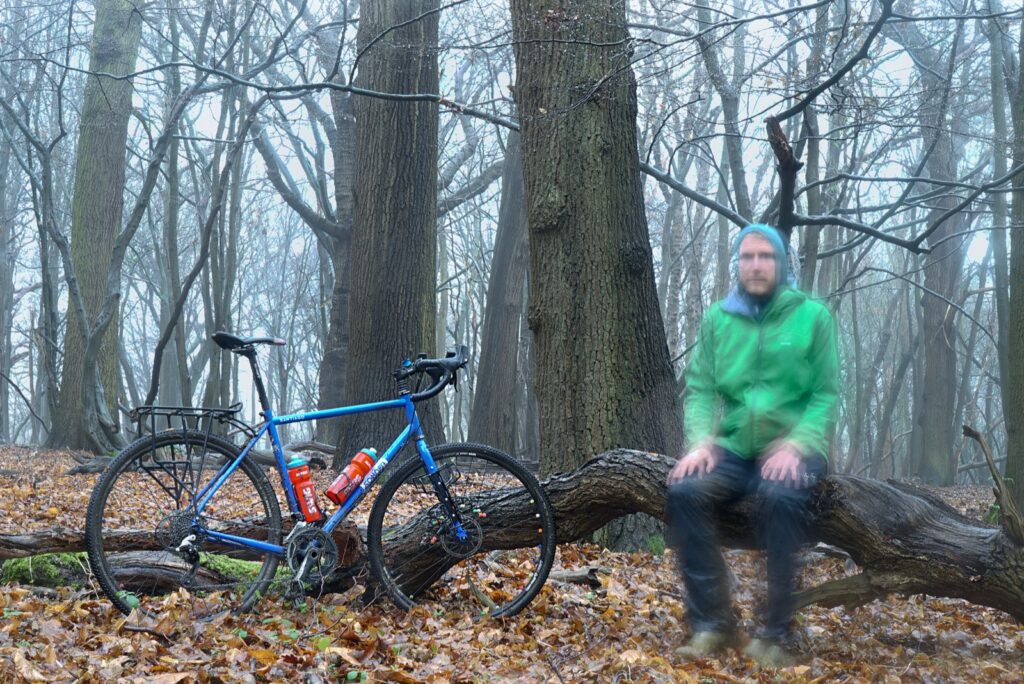
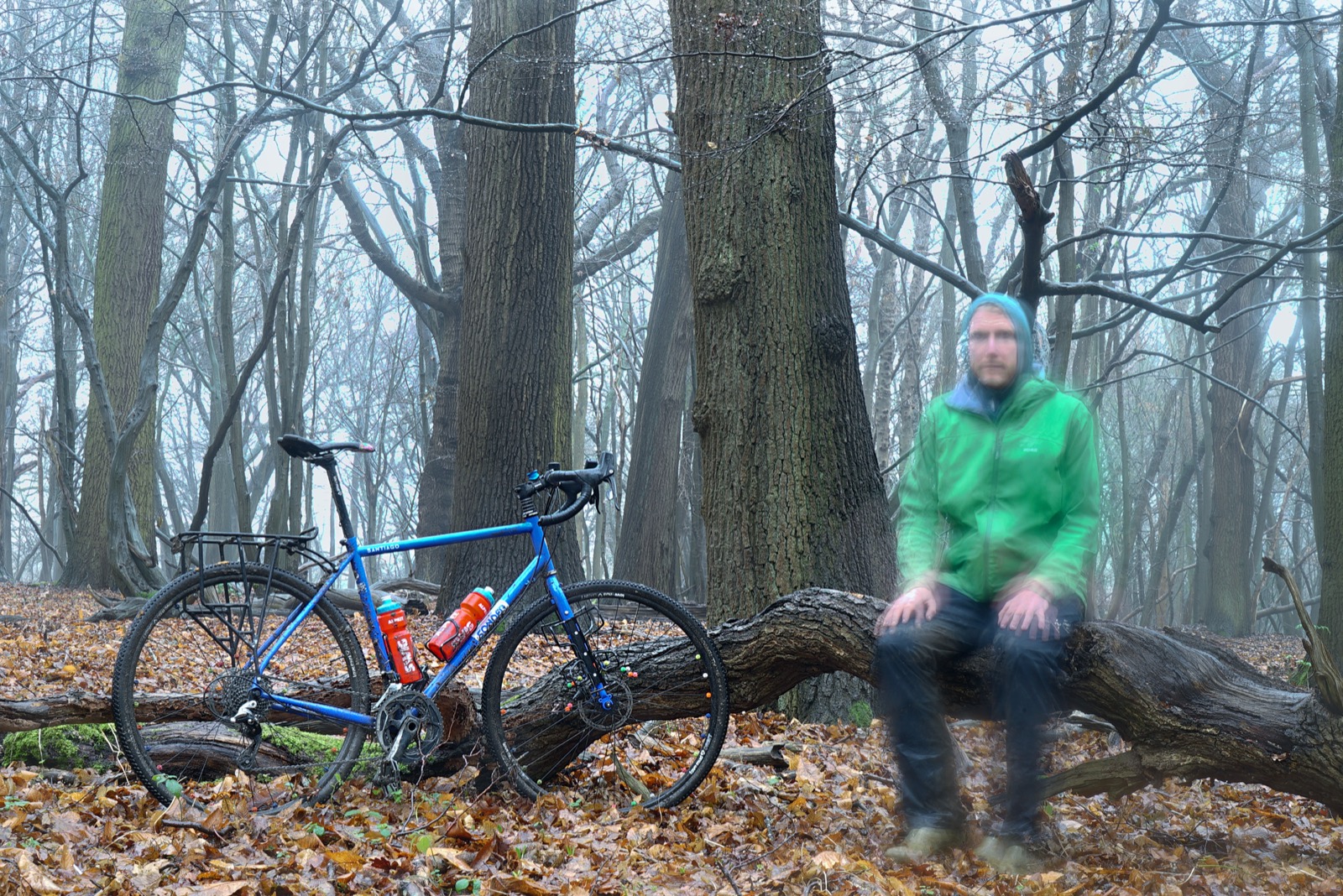



I’ve often thought of sitting alone quietly in the woods for a time. I’ve always been a quiet contemplative person but in adult life time to indulge these things seems to be far too infrequent. I might give this a go soon myself. Thanks for another great grid square Al. Hope you are well. Chris
Do it!
You’ve inspired me to do something similar. My map has a fair bit of sea on it, but also a trip to an island (when circumstances permit).
Good luck!
I love the Brian Doyle quote you shared. I also loved learning about how to guesstimate the age of a foot path. Your photos are storytellers that perfectly capture a wet, mucky day. I am glad you did not let the mud stop you. More than that, I appreciate you taking the time to write about this simple experience. You inspire me every time. Cheers.
I really enjoyed reading this article. Please keep posting them on the blog.
Just got here from reading your newsletter… how cool is all of this! 🙂
you’re an inspiration, Alastair!
This article is an inspiration and reminded me of the time when I took an sabbatical for two months. After feeling like I had to explore the world I rather decided to listen to my deepest desire of really feeling inner silence. So I decided to explore my inner world and to stay in my country. I lived in a Zen community for six weeks. During that time I only stayed close to that place, spend time in the garden and of course set still. This was one of the greatest experience I have ever had. Your article inspired me to embrace the silence as it is one of the greatest gifts in order to reconnect to our true self. Thanks a million for sharing. Love from Germany.
I loved this article! I have just recently started exploring my local ‘braes’ and have been inspired by your articles and book ‘Microadventures’.I turned 60 last year and all my life have wanted to have adventures but was too scared/ unable through circumstances a lot of the time to do anything about it. I wish I had discovered your books/blogs sooner but I am determined to get out there and follow my dreams from now on! Thank you!
Inspirational as always Alistair. I live in a very congested part of the world, sandwiched here between Manchester and Liverpool and I have steadily fallen out of love, even grown to resent where I live. Lockdown has made me feel as if I am in a prison; the hills and woods seem so far away. However, through last autumn, I was already experimenting with making the most of what I had access to. I “joined the 5am club” and was out exploring the local footpaths and small copses, looking for those perfect places where the sun hit first, but were secluded enough to enjoy pitching a hammock and enjoying a coffee and the birdsong, without having to keep looking over my shoulder. Your article has encouraged me to get out doing this again, now that spring is arriving. I intend to create my own 20×20 OS map and look forwards to learning more about the emptier squares in my immediate locale. Who knows, maybe it’ll help me fall back in love with my homelands…
Oh brilliant! Your motives are almost identical to my own. I hope it helps.